Hyundai Santa Fe PHEV vs Hyundai Tucson PHEV
February 4, 2024
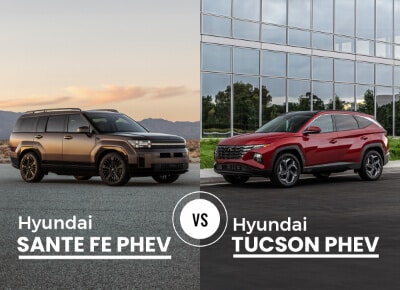

Rich Taber has nearly three decades of professional writing experience, including eight years as an automotive columnist for The Standard-Times newspaper, seven years on staff at WheelsTV as a scriptwriter, production manager, and editorial vice-president, and five years as CEO of RPM News Weekly. He has written extensively for numerous regional and local publications and developed public relations products for many non-profit organizations. Having studied both engineering and liberal arts at the University of Notre Dame and worked in audio/visual services, electronic sales, graphic design, and event and entertainment production, he brings a well-balanced skill set to his automotive writing.
Navigating the world of plug-in hybrids can feel like choosing your hiking buddy – you need someone who matches your pace, preferences, and gear-carrying capacity.
Enter the 2024 Hyundai Santa Fe PHEV and Tucson PHEV, both offering guilt-free electric miles and gas backup.
But which one conquers your eco-conscious adventures?
- Go with the Santa Fe PHEV if you prioritize space, power, optional AWD, or need top IIHS safety ratings.
- Go with the Tucson PHEV if you prioritize agility, slightly better fuel efficiency, standard AWD in some trims, or have frequent charging access and value a lower starting price.
Table of Contents
Hyundai Santa Fe PHEV vs Hyundai Tucson PHEV Comparison
| Specifications | Hyundai Santa Fe PHEV | Hyundai Tucson PHEV |
| Body Style | Mid-Size SUV | Compact SUV |
| Cargo Space (Behind 1st/2nd Row) | 36.1/72.1 cu ft | 37.8/45.8 cu ft |
| Electric Range | 34 miles | 28 miles |
| Combined Fuel Economy | 30 mpg | 33 mpg |
| Towing Capacity | Up to 2,000 lbs | Up to 1,485 lbs |
| Starting Price | Higher ($40,250) | Lower ($38,845) |
What's Similar?
- Plug-in Hybrid Powertrain: Both offer impressive electric driving ranges (34 miles for Santa Fe, 28 miles for Tucson) alongside gas backup for longer journeys.
- Modern & Tech-Infused Interiors: Both boast touchscreens with smartphone integration, available heated seats, and a range of comfort and convenience features.
- Advanced Driver-Assistance Features: Both prioritize safety with standard features like forward collision warning, automatic emergency braking, and lane departure warning.
- Top Safety Ratings: Both received 5-star NHTSA ratings, prioritizing your on-road security.
- Sleek & Stylish Design: Both offer modern and attractive exteriors that will turn heads.
Tale of the Tape
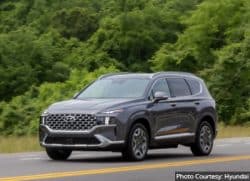 Family adventures require ample space, and the Santa Fe throws down the gauntlet with more headroom, legroom, and cargo capacity. Think road trip essentials, sports equipment, or a furry friend – the Santa Fe accommodates them all.
Family adventures require ample space, and the Santa Fe throws down the gauntlet with more headroom, legroom, and cargo capacity. Think road trip essentials, sports equipment, or a furry friend – the Santa Fe accommodates them all.
However, if navigating city streets and tight parking spots is your priority, the Tucson's compact agility reigns supreme.
Ultimately, choose your champion based on your space needs and driving terrain.
Cabin Quality and Design
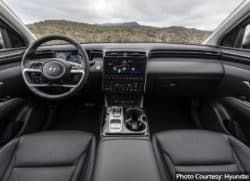 Both SUVs offer modern, tech-infused interiors but with distinct personalities.
Both SUVs offer modern, tech-infused interiors but with distinct personalities.
The Santa Fe might tempt you with premium materials, heated seats standard across trims, and more storage cubbies.
The Tucson counters with a stylish two-tone interior option and heated seats are standard in most trims.
Tech-wise, both boast touchscreens with smartphone integration, but the Santa Fe might offer more features depending on your chosen trim level.
So, prioritize luxury and space with the Santa Fe, or opt for the Tucson's stylish flair and standard comfort features.
Performance & Powertrains
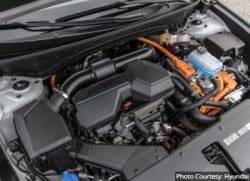 Both hybrids offer satisfying electric ranges (34 miles for the Santa Fe, 28 miles for the Tucson).
Both hybrids offer satisfying electric ranges (34 miles for the Santa Fe, 28 miles for the Tucson).
However, the Santa Fe leans towards combined fuel efficiency, delivering 30 mpg compared to the Tucson's 33 mpg. But don't underestimate the Santa Fe's power – its 261 horsepower trounces the Tucson's 227 horsepower.
Additionally, the Santa Fe offers optional AWD for tackling diverse terrains, while the Tucson sticks to FWD or AWD.
Choose the Santa Fe for power, range, and optional AWD, or the Tucson for its nimble handling and slightly better fuel efficiency
Safety Equipment and Scores
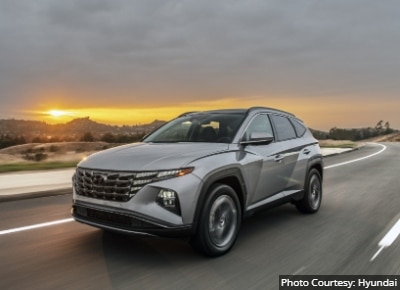 Both prioritize safety with features like forward collision warning and automatic emergency braking, providing peace of mind on the road.
Both prioritize safety with features like forward collision warning and automatic emergency braking, providing peace of mind on the road.
Both received top NHTSA ratings, but the Santa Fe earned a "Good" rating in all IIHS tests, while the Tucson fell short with an "Acceptable" rating on headlights.
So, the Santa Fe might offer a slight safety edge if that's paramount for you.
Current Hyundai Santa Fe PHEV Deals & Incentives
| Year | Make | Model | Cash Incentives (up to) | Best Avail. APR | Lease Offers | Expiration |
|---|---|---|---|---|---|---|
| 2023 | Hyundai | Santa Fe Plug-in Hybrid |
You may qualify for additional deals and incentives, check out this month's Hyundai deals
Current Hyundai Tuscon PHEV Deals & Incentives
| Year | Make | Model | Cash Incentives (up to) | Best Avail. APR | Lease Offers | Expiration |
|---|---|---|---|---|---|---|
| 2023 | Hyundai | Tucson Plug-in Hybrid | ||||
| 2024 | Hyundai | Tucson Plug-in Hybrid | $500 | 2.99% | $349/month for 36 months, $3,999 due at signing | 7/31/24 |
You may qualify for additional deals and incentives, check out this month's Hyundai deals.
So, Which Is Better – the Santa Fe PHEV or the Tucson PHEV?
Need ample space for family adventures? Choose the Santa Fe PHEV. Think spacious tent, optional AWD for off-road fun, and powerful towing.
Crave a sleek city warrior with frequent charging access? Grab the Tucson PHEV. Imagine a stylish backpack, slightly better fuel economy, and standard AWD (in some trims) for light adventures.
Fuel efficiency king? The Tucson PHEV wins by a hair. But remember, the Santa Fe PHEV's longer electric range might be better if charging is limited.
Want pure muscle? The Santa Fe PHEV flexes its 261 horsepower and 2,000 lbs towing capacity.
Safety a top priority? Both shine, but the Santa Fe PHEV edges out with top IIHS ratings.
Price matters? The Tucson PHEV starts lower, but the Santa Fe PHEV offers more space, power, and optional AWD for a slightly higher price.
Frequently Asked Questions
Which has more features, the Santa Fe PHEV or the Tucson PHEV?
These vehicles are priced differently yet mostly offer comparable features. However, the Santa Fe PHEV is not only larger, but also designed to occupy more of the premium space in the SUV market than the Tucson.
Are PHEVs worth the extra money one pays over their traditionally powered counterparts?
Over time, yes, they are. Besides reducing carbon emissions, a PHEV will save enough in fuel costs over its lifetime to more than cover the difference in initial price. Plus, there may be tax incentives that will offset the cost.
Posted in Car Buying Tips, Car Research & Comparisons |







